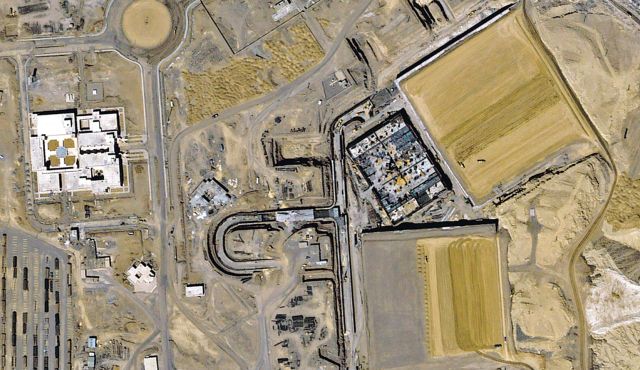There is simply no time for hesitation in addressing this existential threat.
By Dr. Majid Rafizadeh, Gatestone Institute
In the midst of the Hamas-Israel conflict — while the world’s attention is fixed on the war Iran and Hamas began — Iran’s ruling mullahs have seized the opportunity to advance their nuclear program.
By backing, arming and training Hamas, Hezbollah and the Houthis, Iran launched a proxy war against Israel, leveraging the conflict in part to divert attention from its nuclear ambitions.
The calculated move not only serves Iran’s immediate interests in destabilizing its adversaries – the United Arab Emirates, Saudi Arabia, Jordan, Bahrain and most of all the United States, which it would like to see out of the region, so Iran could presumably have the Middle East all to itself.
The diversion of the Gaza war also aligns with its goal of eradicating Israel.
While the mullahs’ proxies wage war on the front lines against the “Little Satan,” Israel, Iran has been maneuvering in the shadows, exploiting the chaos to make significant strides in its nuclear capabilities.
Since the outbreak of the war, Iran’s nuclear weapons program has surged, propelled by clandestine activities within its heavily fortified facility at Fordow.
Revelations from a recent Washington Post report have revealed that behind Iran’s veil of secrecy, its production of enriched uranium has been nearing the 90% level of purity needed for nuclear weapons.
The report illuminates a concerning development: within factory chambers, newly installed equipment, presumably at least partially financed by the US administration, is now humming with the potential to double the facility’s output of enriched uranium.
This clandestine escalation not only breaches the confines of international agreements but also underscores Iran’s determination to build its nuclear weapons as soon as possible.
The Iranian regime’s pursuit of nuclear weapons appears driven foremost by a fervent determination to achieve its long-standing goal of annihilating Israel, a country smaller than New Jersey, which former Iranian President Ali Akbar Hashemi Rafsanjani effectively called a “one-bomb” country: “the use of a nuclear bomb in Israel will leave nothing on the ground, whereas it will only damage the world of Islam.”
Through its support of Hamas, Hezbollah and the Houthis, Iran has been orchestrating a “boiled frog” escalation in hostilities against Israel, by gradually stepping its proxy warfare as a means, for a start, as former Iranian President Mahmoud Ahmadinejad put it, to “wipe Israel off the map.”
Hamas, on October 7, 2023, initiated its brutal attack by launching thousands of rockets at Israel, while approximately 3,000 terrorists crossed the Gaza-Israel barrier, assaulting Israeli military bases and 22 civilian communities.
That onslaught resulted in Hamas terrorists murdering approximately 1,200 people in Israel — Jews, Muslims, Christians, Israelis, foreign workers and tourists, alike. Hamas’s atrocities included gang rapes, torturing men, women and children, as well as baking a baby to death in an oven.
Among other chilling acts were babies beheaded and burned alive. Hamas also seized 240 hostages, who were taken to their tunnels in Gaza.
These barbaric perversions underscore Iran’s leaders’ comfort, if not pleasure, in employing any means at hand to achieve their objectives.
They most likely do not look at their devastation abroad as triggering instability, but, on the contrary, as a means to attaining its hegemony, after which there will be peace — for themselves, at least.
From Iran’s perspective, acquiring nuclear weapons is the easiest way to significantly complete its takeover of the region and “export the revolution:”
“We shall export the revolution to the whole world. Until they cry, ‘there is no god but God [Allah]’ resounds over the whole world, there will be struggle.”
Arming its proxy militias with nuclear capabilities would serve as a lever to reinforce Iran’s strategic position in the region while pretending to obscure its direct involvement.
By providing nuclear weapons to these extremist groups, and potentially others, Iran would not only amplify the threat to its adversaries, but also try to minimize the risk of direct retaliatory strikes on itself.
Unfortunately, the plan poses an existential threat not just to regional stability, but to global security.
Iran has been moving into Latin America, possibly to target the “Great Satan,” the United States.
The prospect of nuclear-armed terrorist groups operating with impunity demands urgent attention.
Given Iran’s reliance on oil and gas revenues to fund its nuclear ambitions, placing and enforcing sanctions against Iran’s oil industry and targeting its oil infrastructure could at least delay its nuclear weapons development.
There should also be efforts to target Iran’s nuclear sites and its brutal Islamic Revolutionary Guard Corps.
There is simply no time for hesitation in addressing this existential threat.
The Iranian regime has shown its unwavering determination to acquire nuclear weapons at any cost.
